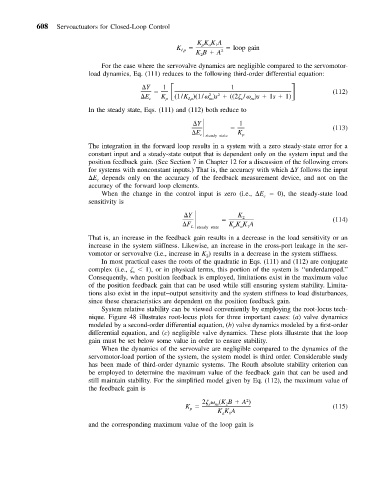Page 617 - Mechanical Engineers' Handbook (Volume 2)
P. 617
608 Servoactuators for Closed-Loop Control
KKKA
1
a
p
K Lp loop gain
KB A 2
2
For the case where the servovalve dynamics are negligible compared to the servomotor-
load dynamics, Eq. (111) reduces to the following third-order differential equation:
Y 1 1 (112)
2
2
E c K p (1/K )(1/ )s ((2 / )s 1s 1)
s
ns
Lp
ns
In the steady state, Eqs. (111) and (112) both reduce to
Y 1 (113)
E K
c steady state p
The integration in the forward loop results in a system with a zero steady-state error for a
constant input and a steady-state output that is dependent only on the system input and the
position feedback gain. (See Section 7 in Chapter 12 for a discussion of the following errors
for systems with nonconstant inputs.) That is, the accuracy with which Y follows the input
E depends only on the accuracy of the feedback measurement device, and not on the
c
accuracy of the forward loop elements.
When the change in the control input is zero (i.e., E 0), the steady-state load
c
sensitivity is
Y K 2
F K K K A (114)
L steady state p a 1
That is, an increase in the feedback gain results in a decrease in the load sensitivity or an
increase in the system stiffness. Likewise, an increase in the cross-port leakage in the ser-
vomotor or servovalve (i.e., increase in K ) results in a decrease in the system stiffness.
2
In most practical cases the roots of the quadratic in Eqs. (111) and (112) are conjugate
complex (i.e., 1), or in physical terms, this portion of the system is ‘‘underdamped.’’
s
Consequently, when position feedback is employed, limitations exist in the maximum value
of the position feedback gain that can be used while still ensuring system stability. Limita-
tions also exist in the input–output sensitivity and the system stiffness to load disturbances,
since these characteristics are dependent on the position feedback gain.
System relative stability can be viewed conveniently by employing the root-locus tech-
nique. Figure 48 illustrates root-locus plots for three important cases: (a) valve dynamics
modeled by a second-order differential equation, (b) valve dynamics modeled by a first-order
differential equation, and (c) negligible valve dynamics. These plots illustrate that the loop
gain must be set below some value in order to ensure stability.
When the dynamics of the servovalve are negligible compared to the dynamics of the
servomotor-load portion of the system, the system model is third order. Considerable study
has been made of third-order dynamic systems. The Routh absolute stability criterion can
be employed to determine the maximum value of the feedback gain that can be used and
still maintain stability. For the simplified model given by Eq. (112), the maximum value of
the feedback gain is
2
2 (KB A )
K sns 2 (115)
p
KKA
a
1
and the corresponding maximum value of the loop gain is

